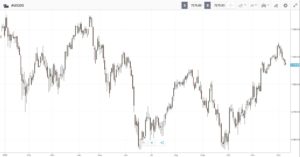The ASX200 snapped two weeks of gains, falling 1.2% last week. The technology and energy sectors were the biggest laggards falling by 4.7% and 3.3%, respectively. The materials sector continued its strong performance this year, gaining 1.87%, taking its 2022 gains to 10%. The energy sector is likely to feel some pain on the ASX200 this week, with oil prices falling by more than 10% last week amid demand concerns.
3 things that happened last week:
1. RBA’s 8th Consecutive Rate Hike
Last week, the Reserve Bank of Australia (RBA) lifted the cash rate by another 25bps to 3.1%. The hike made for no surprises, given this was what the market had expected despite the lower-than-expected inflation reading of 6.9% for October. There were some key takeaways in the monetary statement, none more than “Inflation in Australia is too high”, alluding to the fact there is still plenty of work for the RBA to do. However, the statement also said, “The Board expects to increase interest rates further over the period ahead, but it is not on a pre-set course”, which hints at what the market expects to be another hike in February and then likely a slowdown or pause in the rate hike cycle, before rate cuts at the end of 2023. Importantly, before February’s rate decision, there will still be plenty of economic data ahead, such as Q4 inflation, which will be a focal data point early in 2023.
2. Australian GDP growth slows in Q3
Last week’s Q3 GDP came in at 5.9% year over year, reflecting the rebound from Delta lockdowns last year, however, the number did miss market expectations. Growth quarter-over-quarter did slow to 0.6% despite strong household spending. Consumer spending was the standout, in particular travel, on the back of the global reopening from COVID-19. Despite higher borrowing costs, consumption is still solid for now, but we’re starting to see a moderation. Ultimately, growth in the quarter was not bad, but it does not reflect the full impact of all rate rises from the RBA, given there is usually a few months lag for borrowers to feel the full effects. GDP is expected to slow further heading into 2023, with the RBA forecasting 1.4% growth in 2023.
3. A winner and loser last week from the S&P/ASX200
Fortescue Metals Group Ltd (FMG) was a strong performer last week, rising by 8.69%. The move higher comes after news that Fortescue and Rio Tinto are potentially in planning talks regarding green hydrogen.
Novonix Ltd (NVX) was the worst performer on the ASX200 last week, falling by 23.5%. The lithium battery materials company has come under pressure in the last month after a strong run in October, gaining more than 70%. After its substantial gains, profit-taking from investors is likely driving the current sell-off.
Past performance is not an indication of future results.
3 things to watch for the week ahead:
1. RBA Governor Lowe Speech
Reserve Bank of Australia (RBA) Governor Philip Lowe holds a keynote speech at the 2022 AusPayNet Annual Summit in Sydney on Dec. 13. The address will hopefully provide investors with further insights into the RBA’s 8th consecutive hike and what 2023 may hold for the banks tightening cycle. In his statement last week, Lowe once again mentioned he believes inflation will rise again before the end of the year, peaking at 8% in the December quarter, but he will undoubtedly be happy with October’s monthly reading of just 6.9%, which he referred to in his recent statement. Markets will be wanting to see if the governor hints at another slowdown or a pause in early 2023, although he is unlikely to get ahead of himself before the Q4 inflation reading. The key focus, for now, is whether Philip Lowe and his team can bring down inflation to the RBA’s target rate without tipping the economy into recession.
2. Australian Unemployment Rate
Dec. 15 sees another reading on Australia’s tight labour market. The unemployment rate for October came in at 3.4%, lower than the 3.6% markets had anticipated. Forecasts for November’s reading have yet another fall in the unemployment rate to 3.3% staying near decade lows. According to Roy Morgan, the overall workforce in Australia is sitting at record highs, at 14.9 million people for November, attributing to another drop in unemployment. However, this could be the lowest we see unemployment reach. Economic growth is expected to continue to slow down in 2023; therefore, we will likely see a rise in the unemployment rate again. Rising interest rates, higher input costs and customers tightening their belts means the demand for labour will likely start to decline next year.
3. US Inflation and FOMC Rate Decision
The most watched data point in markets, US CPI, is released next week, followed by the Federal Reserve’s latest policy decision for 2022. US CPI is an important reading for Australian investors to watch, given that sticky inflation would mean the Federal Reserve needs to keep aggressively raising interest rates, ultimately driving a recession. However, there was some positivity in October when the CPI reading came in lower than expected at 7.7% and helped spark a rally on Wall Street, with the Federal Reserve pointing towards a potential slowdown on the horizon. Markets expect another decline for November, with headline CPI estimated at 7.3% and core CPI at 6%. If both readings come in at or below estimates, it’s likely Jerome Powell, and his team will opt for a move lower next week, with a 50 bps hike scaling back from its four consecutive 75 bps hikes. That being said, US CPI has a history of coming in hotter than expected, and Chair Powell has consistently stuck to his hawkish tone, saying the Fed will do whatever is necessary to bring inflation back to target, but the market is still pricing in a 50 bps hike next week.
*All data accurate as of 12/12/2022. Data Source: Bloomberg and eToro
Disclaimer:
This communication is general information and education purposes only and should not be taken as financial product advice, a personal recommendation, or an offer of, or solicitation to buy or sell, any financial product. It has been prepared without taking your objectives, financial situation or needs into account. Any references to past performance and future indications are not, and should not be taken as, a reliable indicator of future results. eToro makes no representation and assumes no liability as to the accuracy or completeness of the content of this publication.


